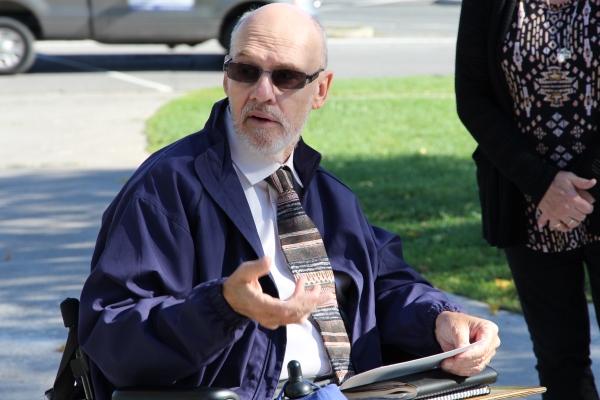Ramping up accessibility
October 5, 2016
Share
![[Duncan McArthur Hall ramp]](/gazette/sites/gazettewww/files/assets/stories/2016/DMH%203.jpg)
The university officially unveiled a number of accessibility improvements at Duncan McArthur Hall during a ribbon-cutting ceremony on Oct. 5.
![[Jill Scott and Dave Stewart]](/gazette/sites/gazettewww/files/assets/stories/2016/DMH%201.jpg)
“Queen’s is committed to improving our buildings and grounds, in order to ensure the full participation of persons with disabilities,” says Teri Shearer, Queen’s Deputy Provost. “I would like to thank the Government of Canada for its support of these upgrades, which will benefit not only students, staff, and faculty, but the broader public who access Duncan McArthur Hall for various community events, performances, and activities.”
The project was made possible with funds from Queen’s and the Enabling Accessibility Fund, which is administered by Employment and Social Development Canada.
This past summer, Queen’s undertook a number of upgrades to the exterior of Duncan McArthur Hall, which houses Queen’s Faculty of Education. The building includes an auditorium and gymnasium that the community can book for performances and events. The improvements include:
• A new concrete accessible ramp leading to the building’s front entrance.
• Two new accessible picnic table platforms.
• Redesign of the parking ticket machine dispenser to remove barriers.
• The installation of several curb cuts that allow persons with disabilities to cross the street in a safe and barrier-free manner.
“It is not uncommon these days to see people are often more disabled by the society they live in than their disability itself. Disabilities exist not because of a person’s body and diagnosis, but because their broader environments are not accessible. The ability to access education, both physically and mentally, is not only an issue of basic human rights, but also one of basic humanity,” says Mark Gerretsen, Member of Parliament for Kingston and the Islands. “This new, inclusive environment will allow people of different physical abilities to share space and activities, and ultimately make this environment accessible to all.”

The improvements are part of Queen's ongoing efforts to enhance accessibility on campus. Queen’s is currently conducting an accessibility audit of the university’s built environment. The information gathered during the audit will help Queen’s identify and remove further barriers across campus.
“The successful implementation of these outdoor accessibility features has not only removed barriers, but has greatly improved the accessible journey sequence to the building and grounds,” says Yvonne Holland, Director, Queen’s Campus Planning and Development.
“In all of our programs, we value and teach accessibility and inclusivity for all learners,” adds Rebecca Luce-Kapler, Dean, Queen’s Faculty of Education. “We feel it’s important that these values are reflected in the environment where our programs are delivered.”